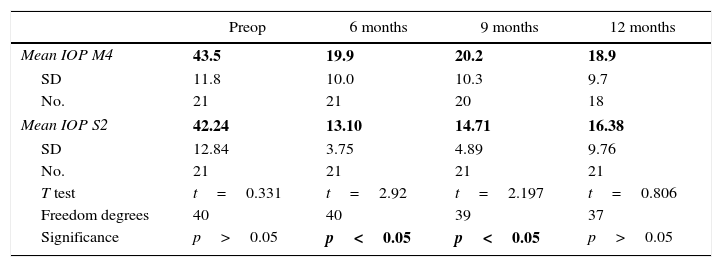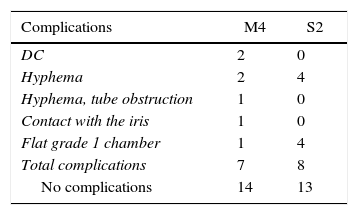To prospectively evaluate the safety and efficacy of the Ahmed glaucoma valve model M4 (high density porous polyethylene plate; Medpor) compared with the model S2 (polypropylene plate).
MethodMexican patients with neovascular glaucoma were randomly included for each group (M4 and S2). They were operated on using conventional techniques and creating a sub-episcleral tunnel to place the valve tube in the anterior chamber.
After one year of follow-up, the results were evaluated with respect to a post-operative reduction in pressure, changes in visual acuity, the need for drugs, and complications, as well as the demographic characteristics of each group.
Each operation using the M4 valve was performed by a single surgeon (FGC). Those operated on using the S2 model had their surgery performed by the staff surgeons at the Glaucoma Department of the Mexican Association to Prevent Blindness (APEC).
ResultsEach group (M4 and S2) contained 21 eyes of 21 Mexican patients with a diagnosis of neovascular glaucoma, leading to a total of 42 patients undergoing surgery. The mean preoperative intraocular pressure (IOP) was 43.5 (±11.8), and 42.24 (±12.84) mmHg for the M4 and S2 groups, respectively. After one year of follow-up, the IOP reported was 18.9 (±9.7) mmHg for the final 18 patients in the M4 group, and 16.38 (±9.76) mmHg for the 21 patients in the S2 group.
DiscussionThe design of a drainage valve device such as that of Ahmed has characteristics such as moderate control of IOP, thanks to the valve component in the immediate post-operative period, which makes them safer than other non-valve devices. This avoids an excess of flat chambers and the presence of low IOPs, which can lead to bleeding in the early post-operative period due to the weak desmosomal junctions of the newly formed vessels, with the advantage of maintaining suitable control of IOP from the first day after surgery.
ConclusionFurther studies with longer follow-up with a larger number of patients are needed to evaluate the effectiveness of this porous coating in the control of neovascular glaucoma.
El objetivo de este estudio fue evaluar de forma prospectiva la seguridad y eficacia del dispositivo valvulado de Ahmed modelo M4 (sistema valvular convencional en plato de polietileno poroso de alta densidad, Medpor) comparado con el modelo S2 (plato de polipropileno).
MétodoSe formaron 2 grupos de pacientes con glaucoma neovascular. Un grupo en el que se implantó el dispositivo M4 y el grupo en el que se implantó el dispositivo S2. En ambos grupos (M4 y S2) se incluyó a pacientes mestizos mexicanos. Dichos pacientes fueron intervenidos quirúrgicamente, utilizando la técnica convencional consistente en la fijación escleral del cuerpo valvular en el cuadrante temporal superior a 8mm del limbo y realizando un túnel subepiescleral para colocar el tubo del dispositivo dentro de la cámara anterior, de acuerdo con la técnica descrita por nuestro grupo en forma previa.
Después de un año de seguimiento los resultados fueron evaluados tomando en cuenta la reducción de la presión intraocular (PIO), los cambios en la agudeza visual, el uso de hipotensores oculares complementarios y las complicaciones aparecidas, así como las características demográficas de cada grupo.
En el caso del modelo M4, los procedimientos quirúrgicos fueron realizados por el mismo cirujano (FGC). Los pacientes en los que se implantó el modelo S2 fueron operados por diversos cirujanos, incluyendo a FGC, del Servicio de Glaucoma del Hospital Dr. Luis Sánchez Bulnes de la Asociación para Evitar la Ceguera en México (APEC).
ResultadosEn cada uno de los 2 grupos se operaron 21 ojos de 21 pacientes con diagnóstico de glaucoma neovascular, conformando los 42 ojos incluidos en este estudio. La PIO promedio en el preoperatorio fue de 43,5mmHg (±11,8) para el grupo de M4 y de 42,24mmHg (±12,84) para el grupo de S2. Después de un año de seguimiento, la PIO reportada fue 18,9mmHg (±9,7) para el grupo de M4 y 16,38mmHg (±9,76) para el grupo de S2.
ConclusionesCreemos que es necesario efectuar un mayor número de estudios a largo plazo con un número mayor de pacientes, para poder evaluar la ayuda de esta cubierta porosa en el control tensional de los pacientes con el diagnóstico de GNV.















